engine coolant FORD F250 SUPER DUTY 2010 Owners Manual
[x] Cancel search | Manufacturer: FORD, Model Year: 2010, Model line: F250 SUPER DUTY, Model: FORD F250 SUPER DUTY 2010Pages: 408, PDF Size: 5.48 MB
Page 3 of 408
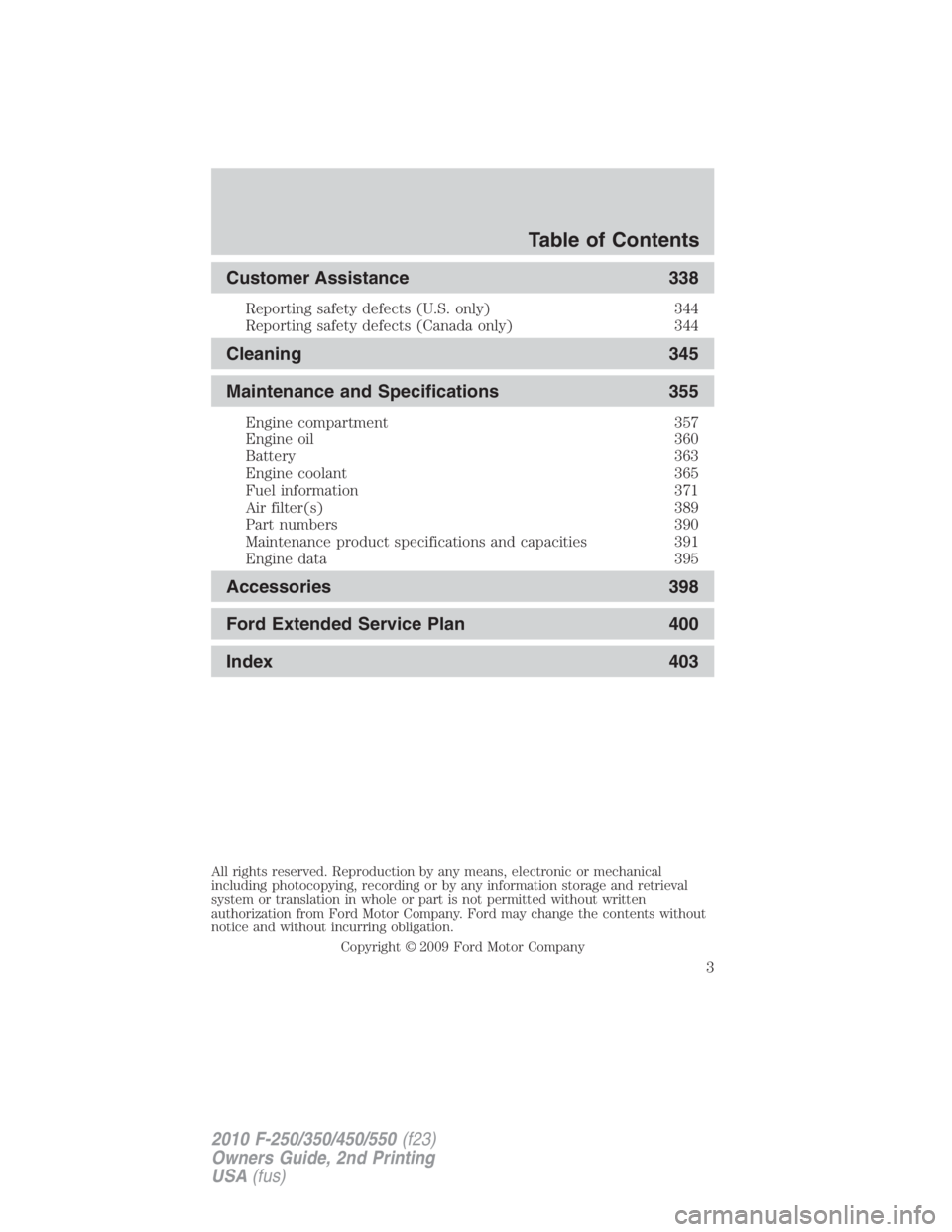
Customer Assistance 338Reporting safety defects (U.S. only) 344
Reporting safety defects (Canada only) 344
Cleaning 345
Maintenance and Specifications 355Engine compartment 357
Engine oil 360
Battery 363
Engine coolant 365
Fuel information 371
Air filter(s) 389
Part numbers 390
Maintenance product specifications and capacities 391
Engine data 395
Accessories 398
Ford Extended Service Plan 400
Index 403
All rights reserved. Reproduction by any means, electronic or mechanical
including photocopying, recording or by any information storage and retrieval
system or translation in whole or part is not permitted without written
authorization from Ford Motor Company. Ford may change the contents without
notice and without incurring obligation.
Copyright © 2009 Ford Motor Company Table of Contents
3
2010 F-250/350/450/550 (f23)
Owners Guide, 2nd Printing
USA (fus)
Page 13 of 408
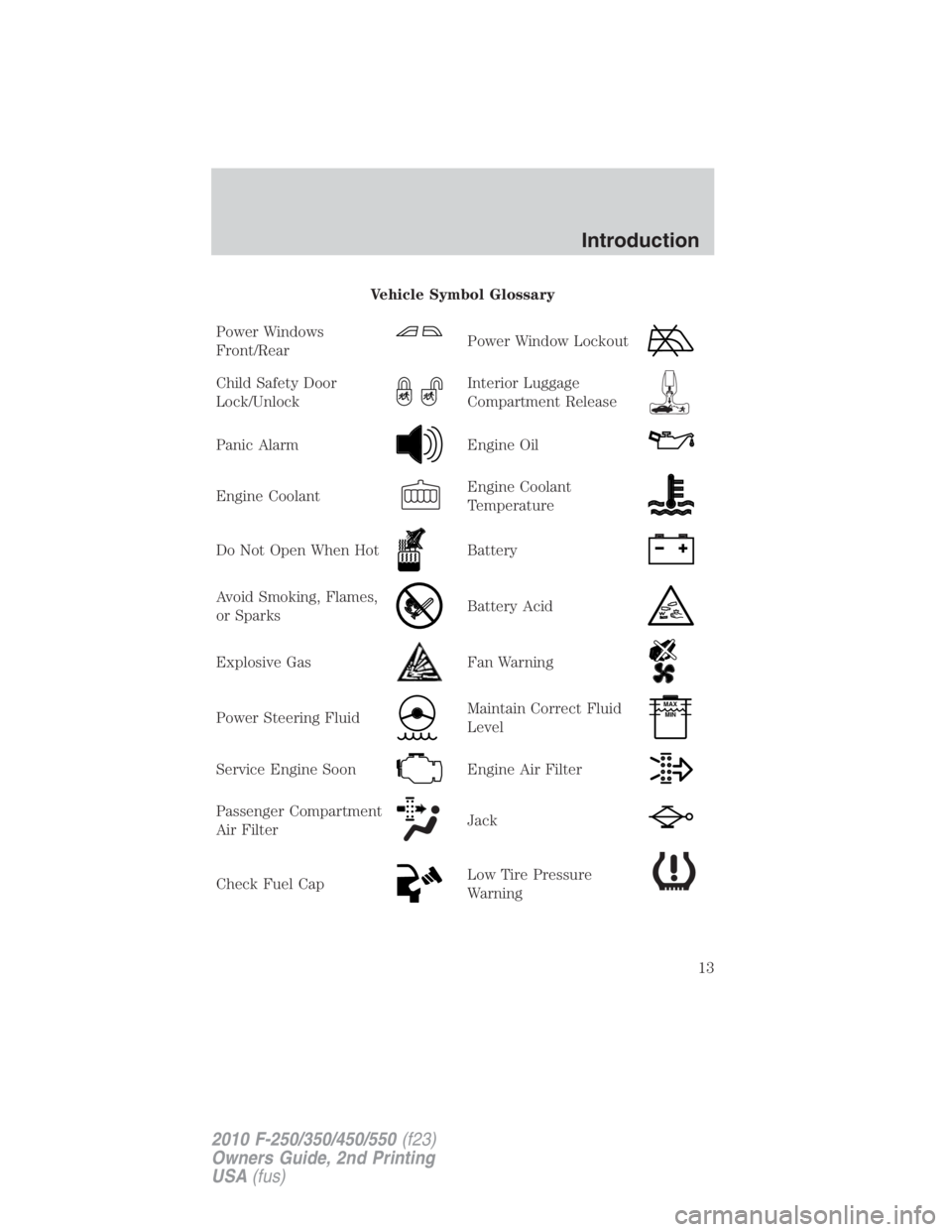
Vehicle Symbol Glossary
Power Windows
Front/Rear Power Window Lockout
Child Safety Door
Lock/Unlock Interior Luggage
Compartment Release
Panic Alarm Engine Oil
Engine Coolant Engine Coolant
Temperature
Do Not Open When Hot Battery
Avoid Smoking, Flames,
or Sparks Battery Acid
Explosive Gas Fan Warning
Power Steering Fluid Maintain Correct Fluid
Level MAX
MIN
Service Engine Soon Engine Air Filter
Passenger Compartment
Air Filter Jack
Check Fuel Cap Low Tire Pressure
WarningIntroduction
13
2010 F-250/350/450/550 (f23)
Owners Guide, 2nd Printing
USA (fus)
Page 18 of 408
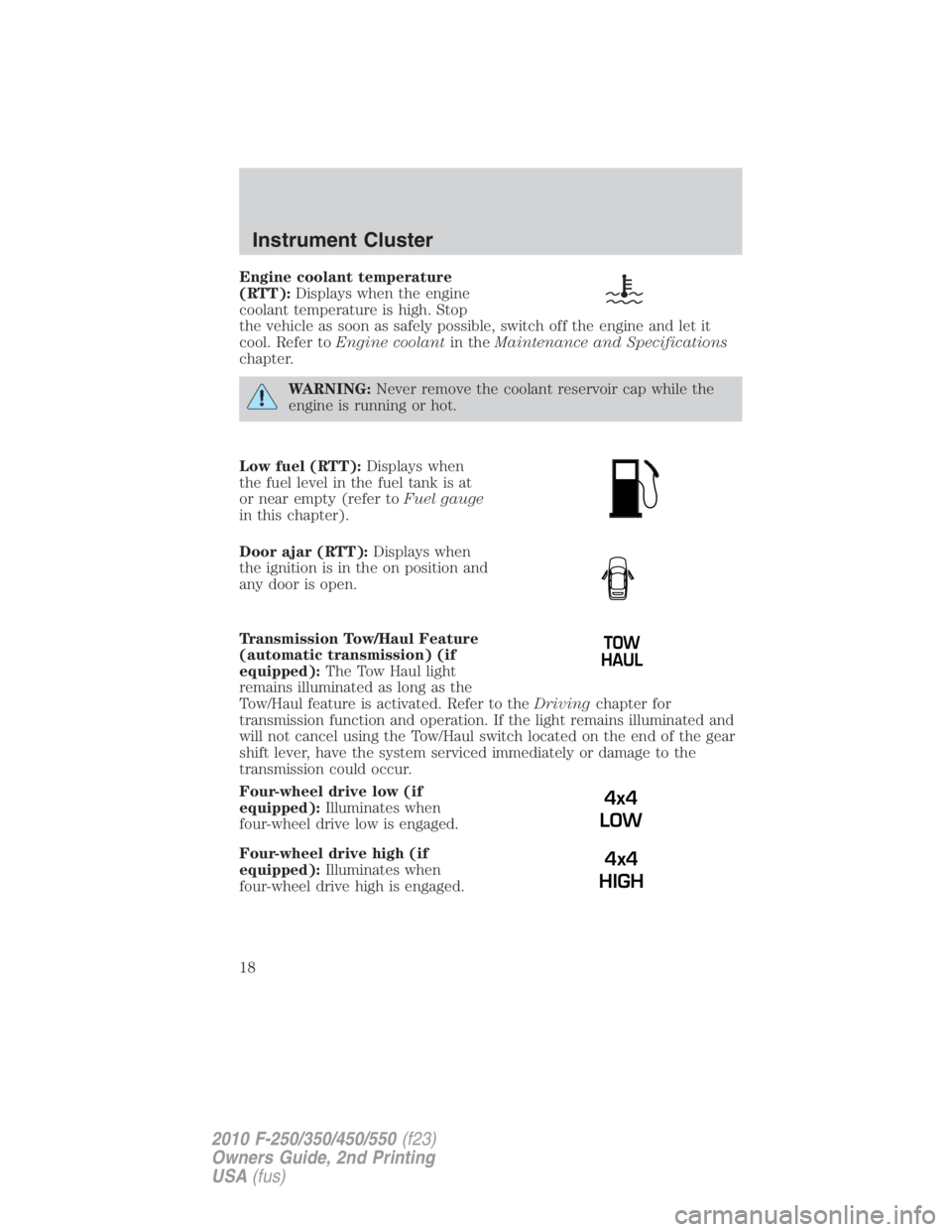
Engine coolant temperature
(RTT): Displays when the engine
coolant temperature is high. Stop
the vehicle as soon as safely possible, switch off the engine and let it
cool. Refer to Engine coolant in the Maintenance and Specifications
chapter.
WARNING: Never remove the coolant reservoir cap while the
engine is running or hot.
Low fuel (RTT): Displays when
the fuel level in the fuel tank is at
or near empty (refer to Fuel gauge
in this chapter).
Door ajar (RTT): Displays when
the ignition is in the on position and
any door is open.
Transmission Tow/Haul Feature
(automatic transmission) (if
equipped): The Tow Haul light
remains illuminated as long as the
Tow/Haul feature is activated. Refer to the Driving chapter for
transmission function and operation. If the light remains illuminated and
will not cancel using the Tow/Haul switch located on the end of the gear
shift lever, have the system serviced immediately or damage to the
transmission could occur.
Four-wheel drive low (if
equipped): Illuminates when
four-wheel drive low is engaged.
Four-wheel drive high (if
equipped): Illuminates when
four-wheel drive high is engaged. 4x4
LOW
4x4
HIGHInstrument Cluster
18
2010 F-250/350/450/550 (f23)
Owners Guide, 2nd Printing
USA (fus)
Page 21 of 408
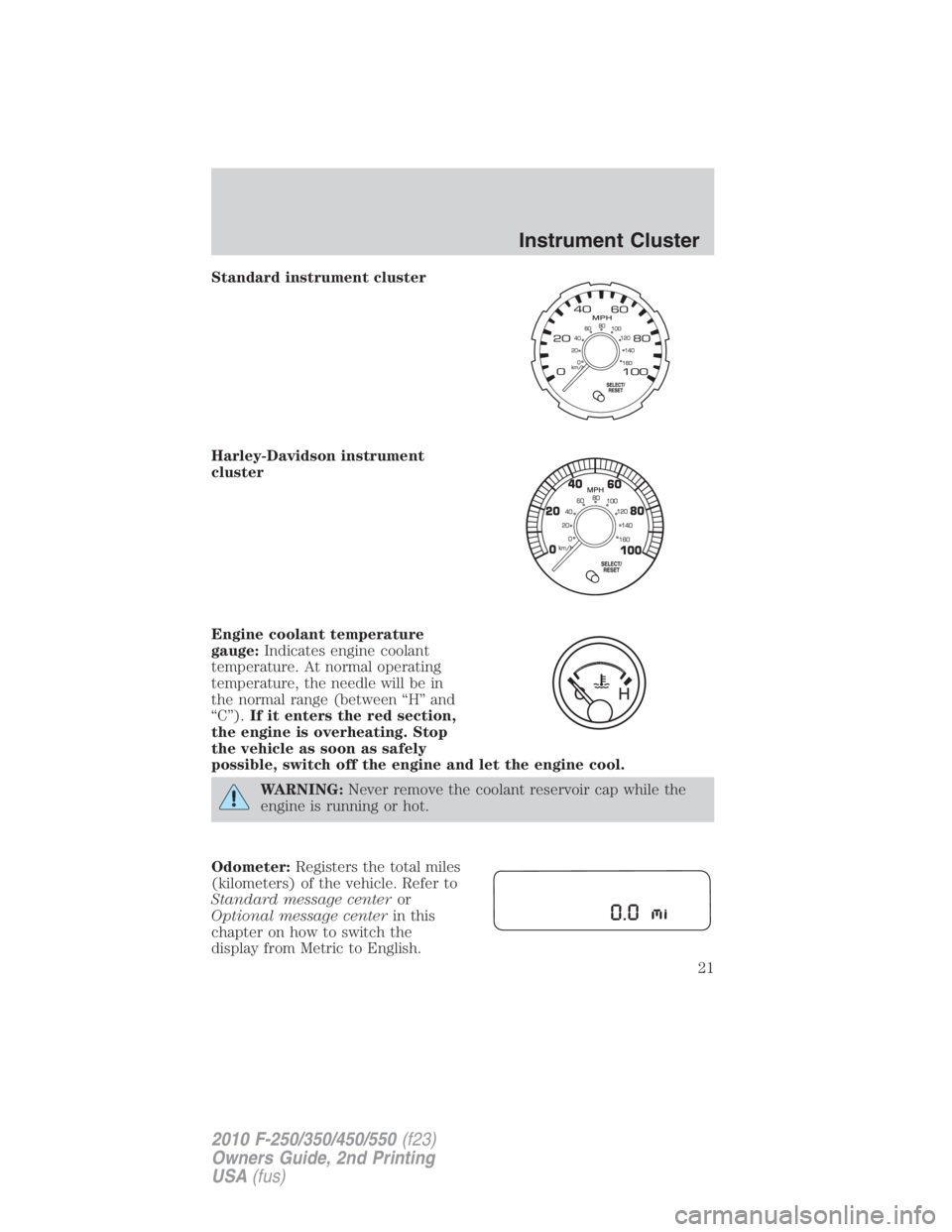
Standard instrument cluster
Harley-Davidson instrument
cluster
Engine coolant temperature
gauge: Indicates engine coolant
temperature. At normal operating
temperature, the needle will be in
the normal range (between “H” and
“C”). If it enters the red section,
the engine is overheating. Stop
the vehicle as soon as safely
possible, switch off the engine and let the engine cool.
WARNING: Never remove the coolant reservoir cap while the
engine is running or hot.
Odometer: Registers the total miles
(kilometers) of the vehicle. Refer to
Standard message center or
Optional message center in this
chapter on how to switch the
display from Metric to English. Instrument Cluster
21
2010 F-250/350/450/550 (f23)
Owners Guide, 2nd Printing
USA (fus)
Page 267 of 408
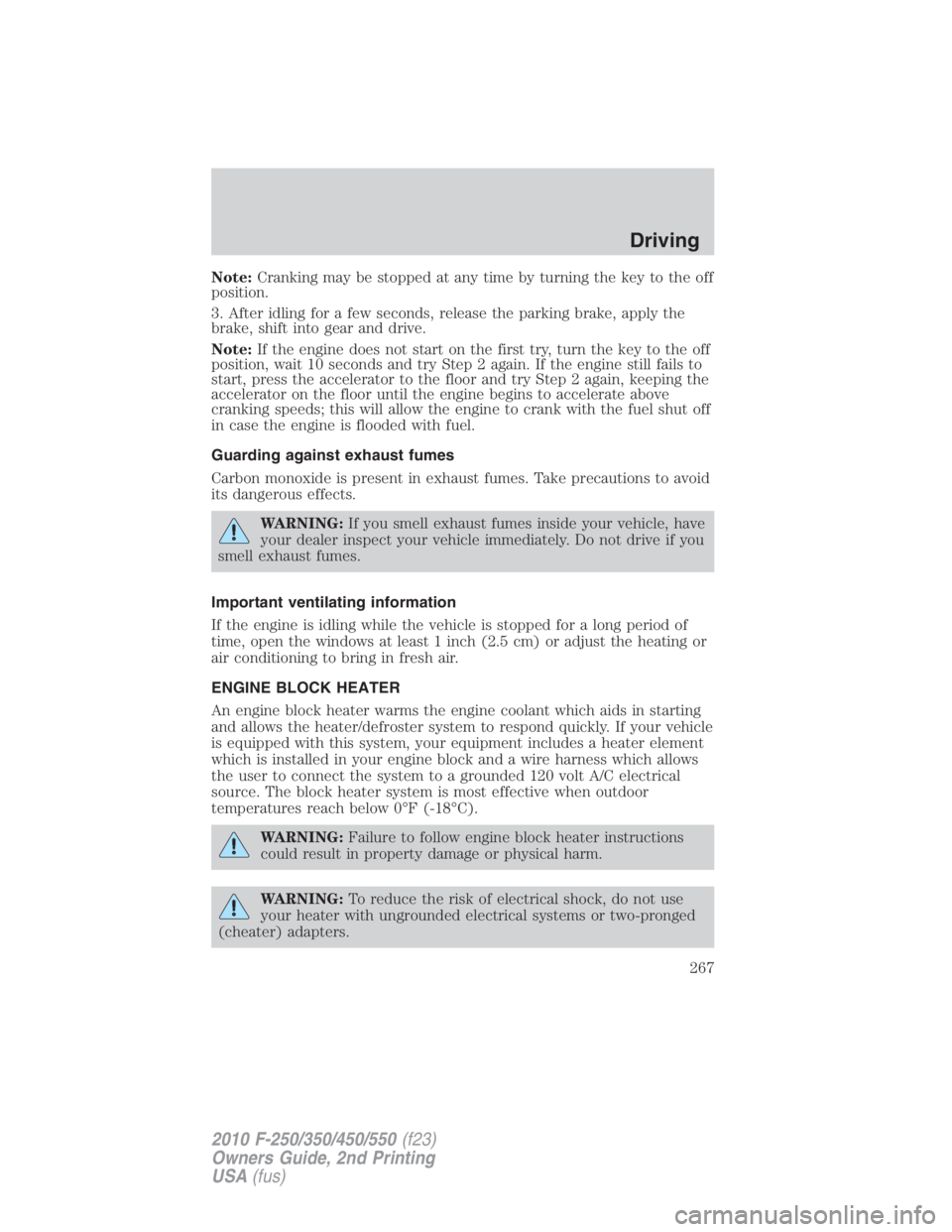
Note: Cranking may be stopped at any time by turning the key to the off
position.
3. After idling for a few seconds, release the parking brake, apply the
brake, shift into gear and drive.
Note: If the engine does not start on the first try, turn the key to the off
position, wait 10 seconds and try Step 2 again. If the engine still fails to
start, press the accelerator to the floor and try Step 2 again, keeping the
accelerator on the floor until the engine begins to accelerate above
cranking speeds; this will allow the engine to crank with the fuel shut off
in case the engine is flooded with fuel.
Guarding against exhaust fumes
Carbon monoxide is present in exhaust fumes. Take precautions to avoid
its dangerous effects.
WARNING: If you smell exhaust fumes inside your vehicle, have
your dealer inspect your vehicle immediately. Do not drive if you
smell exhaust fumes.
Important ventilating information
If the engine is idling while the vehicle is stopped for a long period of
time, open the windows at least 1 inch (2.5 cm) or adjust the heating or
air conditioning to bring in fresh air.
ENGINE BLOCK HEATER
An engine block heater warms the engine coolant which aids in starting
and allows the heater/defroster system to respond quickly. If your vehicle
is equipped with this system, your equipment includes a heater element
which is installed in your engine block and a wire harness which allows
the user to connect the system to a grounded 120 volt A/C electrical
source. The block heater system is most effective when outdoor
temperatures reach below 0°F (-18°C).
WARNING: Failure to follow engine block heater instructions
could result in property damage or physical harm.
WARNING: To reduce the risk of electrical shock, do not use
your heater with ungrounded electrical systems or two-pronged
(cheater) adapters. Driving
267
2010 F-250/350/450/550 (f23)
Owners Guide, 2nd Printing
USA (fus)
Page 357 of 408
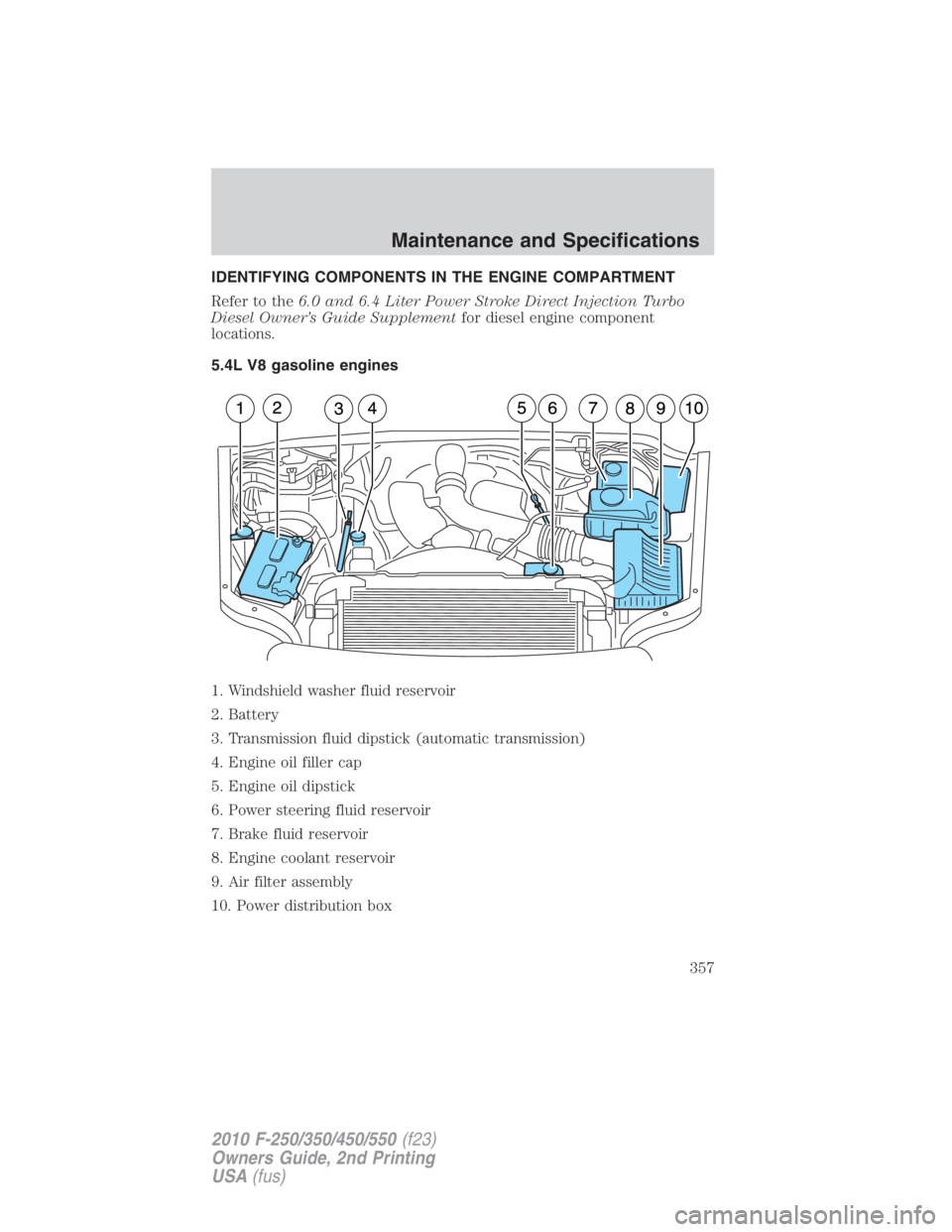
IDENTIFYING COMPONENTS IN THE ENGINE COMPARTMENT
Refer to the 6.0 and 6.4 Liter Power Stroke Direct Injection Turbo
Diesel Owner’s Guide Supplement for diesel engine component
locations.
5.4L V8 gasoline engines
1. Windshield washer fluid reservoir
2. Battery
3. Transmission fluid dipstick (automatic transmission)
4. Engine oil filler cap
5. Engine oil dipstick
6. Power steering fluid reservoir
7. Brake fluid reservoir
8. Engine coolant reservoir
9. Air filter assembly
10. Power distribution box Maintenance and Specifications
357
2010 F-250/350/450/550 (f23)
Owners Guide, 2nd Printing
USA (fus)
Page 358 of 408
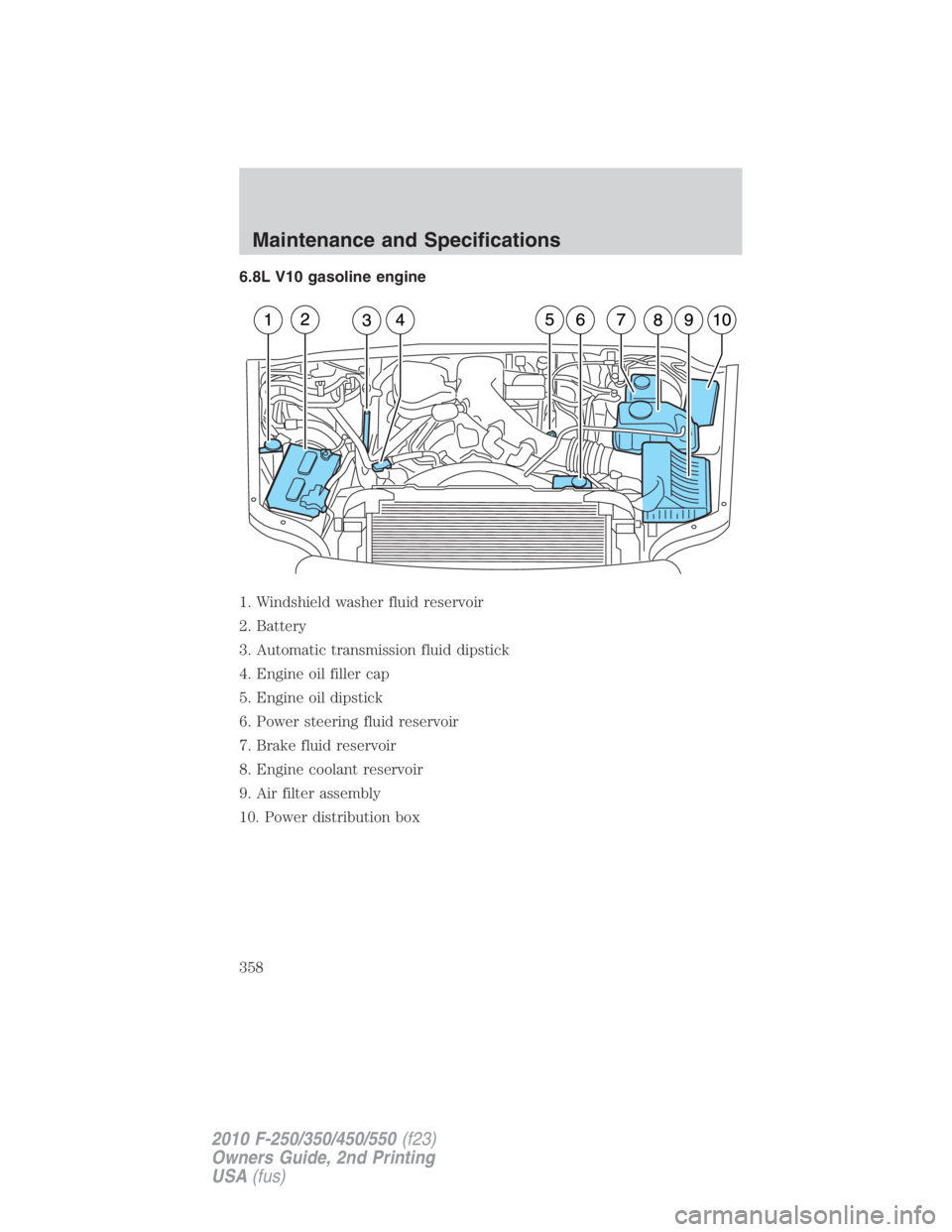
6.8L V10 gasoline engine
1. Windshield washer fluid reservoir
2. Battery
3. Automatic transmission fluid dipstick
4. Engine oil filler cap
5. Engine oil dipstick
6. Power steering fluid reservoir
7. Brake fluid reservoir
8. Engine coolant reservoir
9. Air filter assembly
10. Power distribution boxMaintenance and Specifications
358
2010 F-250/350/450/550 (f23)
Owners Guide, 2nd Printing
USA (fus)
Page 365 of 408
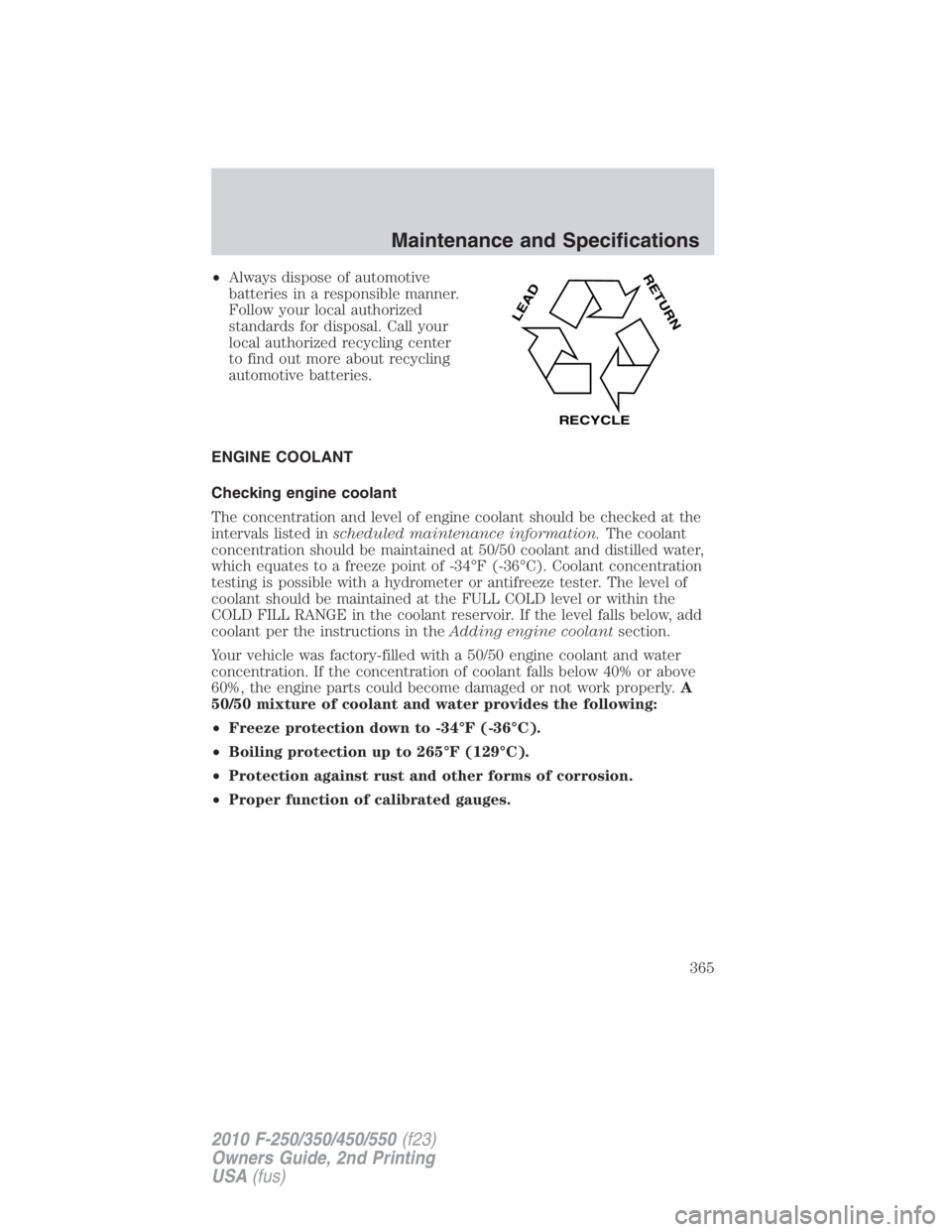
• Always dispose of automotive
batteries in a responsible manner.
Follow your local authorized
standards for disposal. Call your
local authorized recycling center
to find out more about recycling
automotive batteries.
ENGINE COOLANT
Checking engine coolant
The concentration and level of engine coolant should be checked at the
intervals listed in scheduled maintenance information. The coolant
concentration should be maintained at 50/50 coolant and distilled water,
which equates to a freeze point of -34°F (-36°C). Coolant concentration
testing is possible with a hydrometer or antifreeze tester. The level of
coolant should be maintained at the FULL COLD level or within the
COLD FILL RANGE in the coolant reservoir. If the level falls below, add
coolant per the instructions in the Adding engine coolant section.
Your vehicle was factory-filled with a 50/50 engine coolant and water
concentration. If the concentration of coolant falls below 40% or above
60%, the engine parts could become damaged or not work properly. A
50/50 mixture of coolant and water provides the following:
• Freeze protection down to -34°F (-36°C).
• Boiling protection up to 265°F (129°C).
• Protection against rust and other forms of corrosion.
• Proper function of calibrated gauges.
L E A D
RETURN
RECYCLE
Maintenance and Specifications
365
2010 F-250/350/450/550 (f23)
Owners Guide, 2nd Printing
USA (fus)
Page 366 of 408
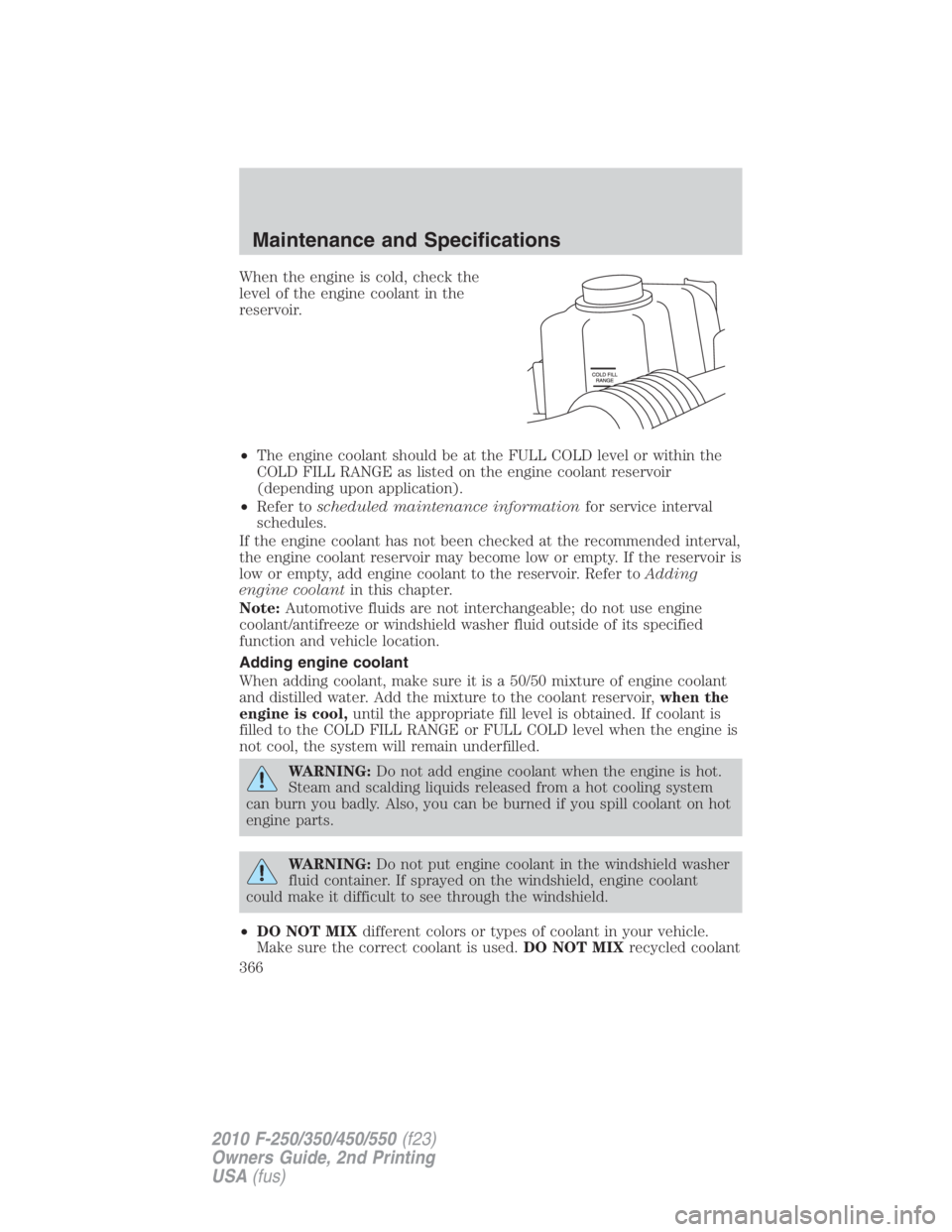
When the engine is cold, check the
level of the engine coolant in the
reservoir.
• The engine coolant should be at the FULL COLD level or within the
COLD FILL RANGE as listed on the engine coolant reservoir
(depending upon application).
• Refer to scheduled maintenance information for service interval
schedules.
If the engine coolant has not been checked at the recommended interval,
the engine coolant reservoir may become low or empty. If the reservoir is
low or empty, add engine coolant to the reservoir. Refer to Adding
engine coolant in this chapter.
Note: Automotive fluids are not interchangeable; do not use engine
coolant/antifreeze or windshield washer fluid outside of its specified
function and vehicle location.
Adding engine coolant
When adding coolant, make sure it is a 50/50 mixture of engine coolant
and distilled water. Add the mixture to the coolant reservoir, when the
engine is cool, until the appropriate fill level is obtained. If coolant is
filled to the COLD FILL RANGE or FULL COLD level when the engine is
not cool, the system will remain underfilled.
WARNING: Do not add engine coolant when the engine is hot.
Steam and scalding liquids released from a hot cooling system
can burn you badly. Also, you can be burned if you spill coolant on hot
engine parts.
WARNING: Do not put engine coolant in the windshield washer
fluid container. If sprayed on the windshield, engine coolant
could make it difficult to see through the windshield.
• DO NOT MIX different colors or types of coolant in your vehicle.
Make sure the correct coolant is used. DO NOT MIX recycled coolantMaintenance and Specifications
366
2010 F-250/350/450/550 (f23)
Owners Guide, 2nd Printing
USA (fus)
Page 367 of 408
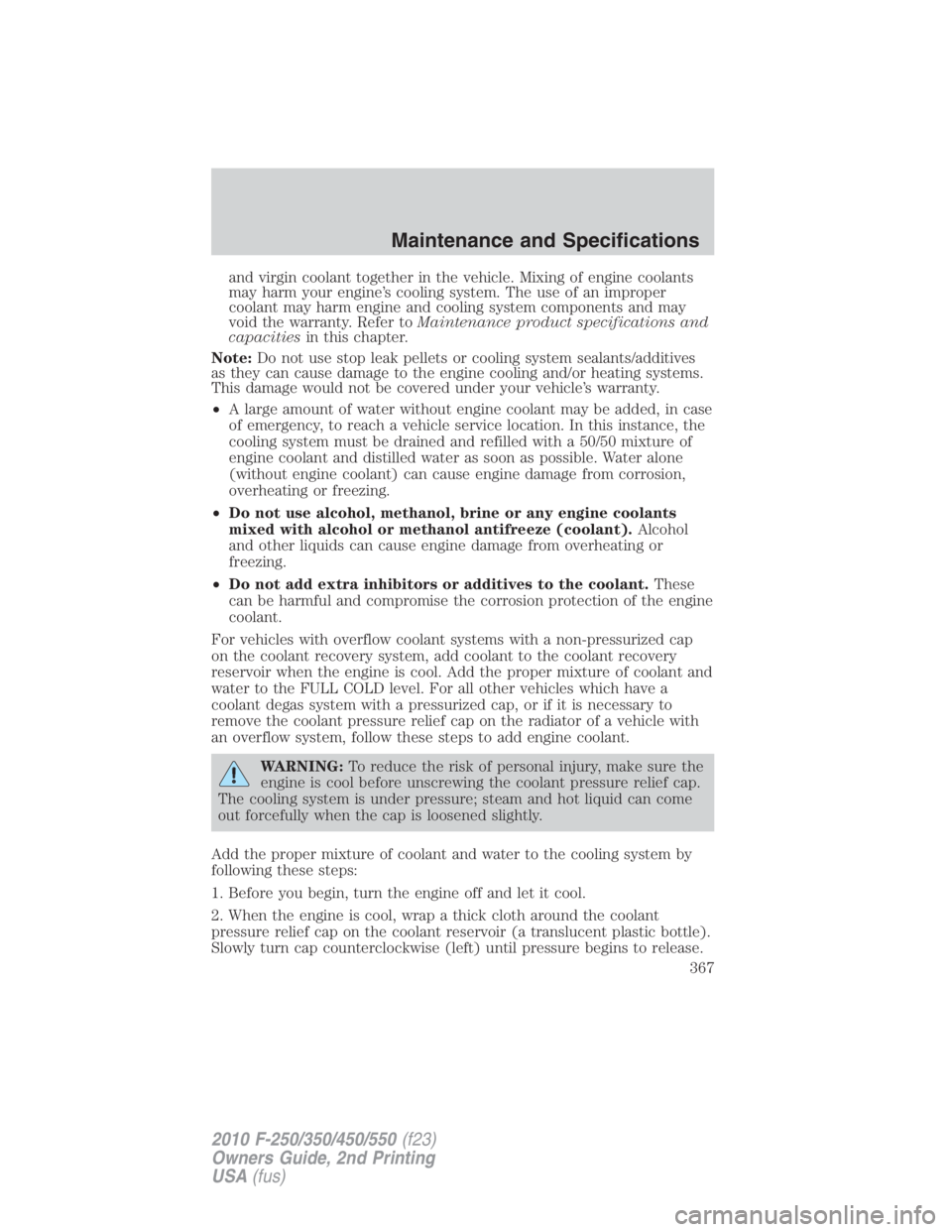
and virgin coolant together in the vehicle. Mixing of engine coolants
may harm your engine’s cooling system. The use of an improper
coolant may harm engine and cooling system components and may
void the warranty. Refer to Maintenance product specifications and
capacities in this chapter.
Note: Do not use stop leak pellets or cooling system sealants/additives
as they can cause damage to the engine cooling and/or heating systems.
This damage would not be covered under your vehicle’s warranty.
• A large amount of water without engine coolant may be added, in case
of emergency, to reach a vehicle service location. In this instance, the
cooling system must be drained and refilled with a 50/50 mixture of
engine coolant and distilled water as soon as possible. Water alone
(without engine coolant) can cause engine damage from corrosion,
overheating or freezing.
• Do not use alcohol, methanol, brine or any engine coolants
mixed with alcohol or methanol antifreeze (coolant). Alcohol
and other liquids can cause engine damage from overheating or
freezing.
• Do not add extra inhibitors or additives to the coolant. These
can be harmful and compromise the corrosion protection of the engine
coolant.
For vehicles with overflow coolant systems with a non-pressurized cap
on the coolant recovery system, add coolant to the coolant recovery
reservoir when the engine is cool. Add the proper mixture of coolant and
water to the FULL COLD level. For all other vehicles which have a
coolant degas system with a pressurized cap, or if it is necessary to
remove the coolant pressure relief cap on the radiator of a vehicle with
an overflow system, follow these steps to add engine coolant.
WARNING: To reduce the risk of personal injury, make sure the
engine is cool before unscrewing the coolant pressure relief cap.
The cooling system is under pressure; steam and hot liquid can come
out forcefully when the cap is loosened slightly.
Add the proper mixture of coolant and water to the cooling system by
following these steps:
1. Before you begin, turn the engine off and let it cool.
2. When the engine is cool, wrap a thick cloth around the coolant
pressure relief cap on the coolant reservoir (a translucent plastic bottle).
Slowly turn cap counterclockwise (left) until pressure begins to release. Maintenance and Specifications
367
2010 F-250/350/450/550 (f23)
Owners Guide, 2nd Printing
USA (fus)